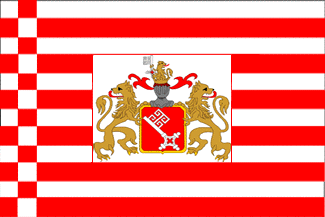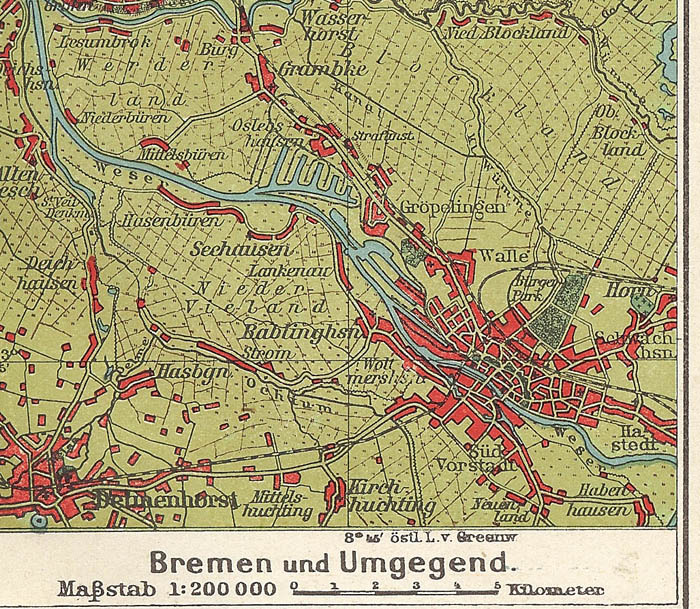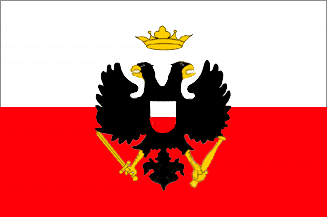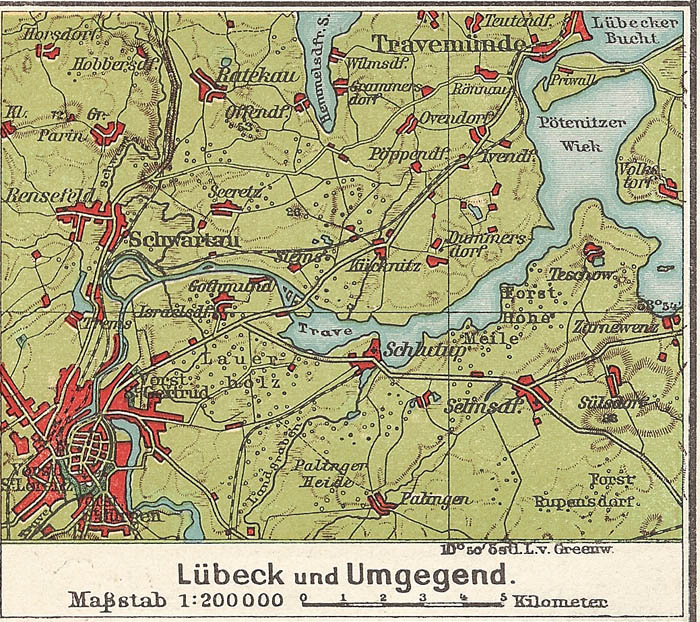Hansiatc Cities
The name Hanseatic really referred to a league of trading cities that dated back to the 13th century. By the late 1800s, the meaning was limited to the German cities of Hamburg, Bremen, and Lübeck.
Bremen


(1813-1871)
The Free Hanseatic City of Bremen, a German state since 1646, was a member state of the German Confederation between 1815 and 1866. After the Prussian-Austrian War, it became a member state of the North German Confederation in 1867. In 1869, Prussia granted territory to Bremen to give it control of Bremerhaven at the mouth of the Weser River and some other small ports along the river. It became a member state of the German Empire in 1871.
About 93 percent of the population was Protestant, six percent Roman Catholic, and only two percent Jewish. The government was a republic with a two chamber parliament — the Senate and the Bürgerschaft. The senate was composed of sixteen life members elected by the Bürgerschaft. Two of the Senators were elected by their colleagues as Burgomasters, who presided over the republic in succession for a year at a time. The Bürgerschaft consisted of 150 representatives, chosen by the citizens for six years and formed the legislative body. Fourteen members were elected by the most educated citizens (university graduates) of Bremen, 40 by the merchants, 20 by the manufacturers and artisans, and 48 by the other citizens. Of the remaining representatives, Bremerhaven, Vegesack, and sixteen by the rural districts furnished 12. As a member of the Imperial German Empire, the State of Bremen had one vote in the Bundesrat and had one deputy in the Reichstag. Bremen joined the Zollverein quite late in 1888 with the exception of two small free districts in Bremen and Bremerhaven.
Consuls were maintained for trade with Prussia, Austria-Hungary, Russia, USA, Argentina, Anhalt, London, Bavaria, Belgian, Chile, Colombia, Ecuador, France, Great Britain, Italy, Lippe, Mecklenburg, the Netherlands, Paraguay, Saxony, Schaumburg-Lippe, Sweden, Norway, Turkey, and Württemberg.
In 1914, the population was approximately 326,000.
Hamburg


(1813-1871)
The Free and Hanseatic City of Hamburg was a German state since 1618. It was a member state of the Germanic Confederation between 1815 and 1866. After the Prussian-Austrian War, it became a member state of the North German Confederation in 1867. Hamburg became a member state of the German Empire in 1871.
Hamburg had one representative in the Bundesrat and three deputies in the Reichstag. Hamburg was a republic with the parliament having two chambers, the Senate and the Bürgerschaft. The Senate, which exercised the greater part of the executive power, was composed of eighteen life members. The Bürgerschaft elected the members of the Senate for life. There were two mayors. However, a chief burgomaster, called “Magnificence,” was chosen annually in secret ballot and had a two- year term limit. The House of Burgesses consisted of 160 members who were elected using a unique three tiered system. Eighty members were elected by secret ballot of all tax-paying citizens, 40 members by the owners of real estate within the city, and the remaining 40 were elected directly by the “notables” for a period of six years. The senate could veto
all legislation except taxation; if the two bodies differed, the issue was referred to a court of arbitration.
Consuls were maintained for trade with Prussia, Austria-Hungary, Russia, USA, Anhalt, Argentina, Baden, Bavaria, Belgium, Olivia, Brazil, Chile, Colombia, Costa Rica, Cuba, Denmark, Dominican Republic, Ecuador, France, Great Britain, Greece, Guatemala, Haiti, Hesse, Honduras , Italy, Congo, Korea, Liberia, Lippe, Mecklenburg-Schwerin, Mecklenburg-Strelitz, Mexico, Nicaragua, the Netherlands, Panama, Paraguay, Persia, Peru, Portugal, Reuss older line, Rumania, Saxony, San Salvador, Sweden, Norway, Switzerland, Serbia, Siam, Spain, Turkey, Uruguay Venezuela, and Württemberg.
In 1914, the population was approximately 1,099,000.
Lübeck


(1813-1871)
The Free and Hanseatic City of Lübeck, a German state since 1226, was a member state of the Germanic Confederation from 1815 to 1866. After the Prussian-Austrian War, it became a member state of the North German Confederation in 1867. It became a member state of the German Empire in 1871.
There is some confusion because there is a principality of Lübeck, which is a province of Oldenburg, and also a separate entity, the Free City of Lübeck.
The Free State was a republic and Parliament consisted of two chambers. The Senate of fourteen life members was elected by a joint session of the Senate and the lower house. The Senate was presided over by the Oberbürgermeister, who during his two-year term of office was called “Magnificence” and was also considered the president of the Senate and the head of the republic. All citizens possessing four-year longevity elected the lower house (Bürgerschaft) of 130 members under a unique two-class property system and who paid income tax. The Bürgerschaft had the right of initiating legislation, including that relative to foreign treaties.
Consuls were maintained for trade with Prussia, Brazil, Austria-Hungary, Russia, Argentina Bavaria, Belgium, Denmark, France, Great Britain, Italy, Netherlands, Oldenburg, Portugal, Sweden, Norway, Spain, Venezuela, USA, and Württemberg.
